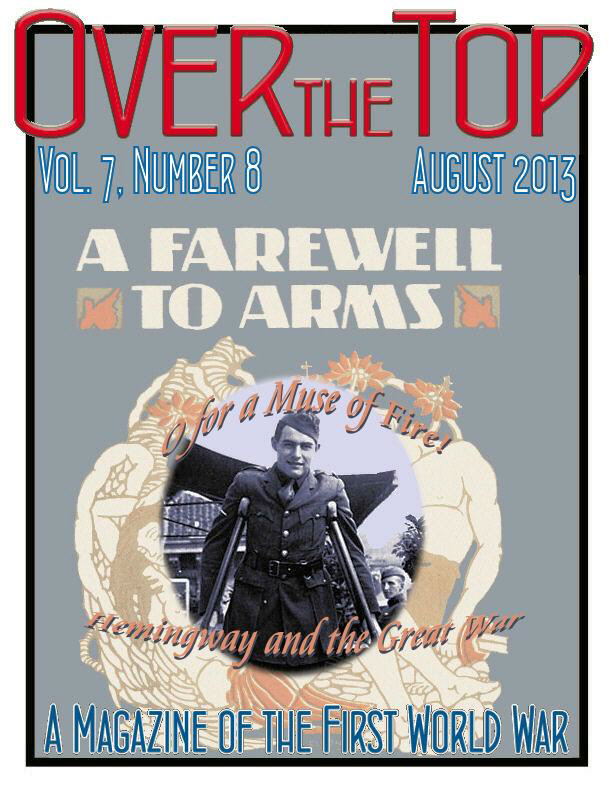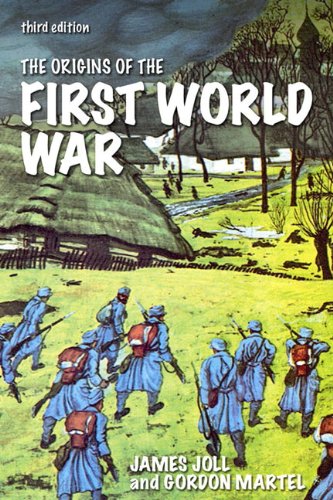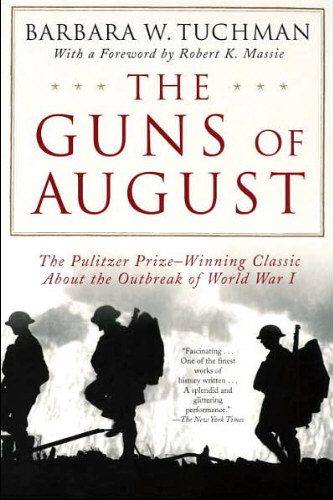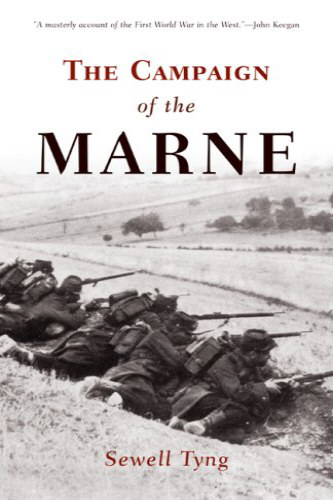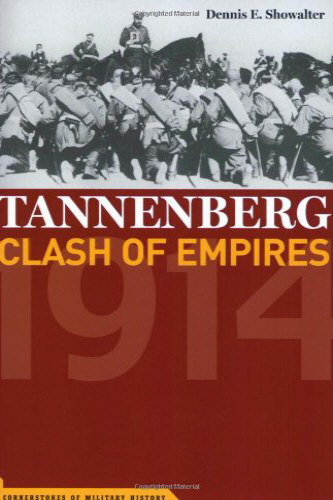
August 2013 |
 |
|


Welcome to our latest issue. We appreciate the wonderful comments you have sent us about our new design and our new emphasis on full coverage of the preparations of the centennial commemoration. We also have heard the message that you don't want us to drop any more of your favorite features.
Actually, together with our new daily blog Roads to the Great War we have not eliminated anything we have presented in the past but are regularly adding more material. Since late May we have added almost 75 new articles at Roads on every aspect of the Great War, including a dozen book reviews, plus veterans' profiles (9), hardcore military history (19), visual essays (16), arts & humor (10), and visiting battlefields (8).
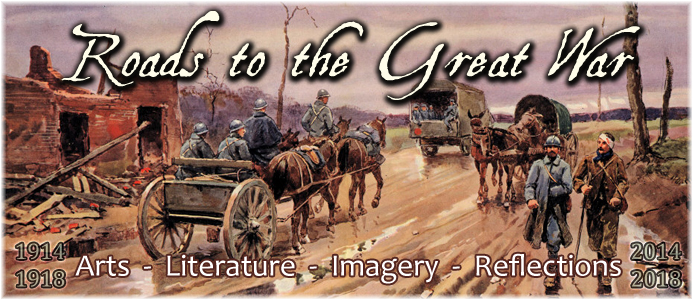
To enjoy all the material we are offering please click on the masthead above to start visiting Roads. To see the full list of articles referred to above, just open up the archives on the right side of the page. If you're impressed wth what you see, please subscribe so we will start building up traffic to attract the attention of the search engines. MH

|
2013
 First Division Museum at Cantigny, "Faces of the 1st," including extensive coverage of WWI, Wheaton, Il, through 2 September 2013. Online Exhibit. First Division Museum at Cantigny, "Faces of the 1st," including extensive coverage of WWI, Wheaton, Il, through 2 September 2013. Online Exhibit.
 New York State Military Museum, "Fiery Trial and Sacrifice - New York and the First World War," ongoing exhibit, Saratoga Springs, NY. Virtual Tour. New York State Military Museum, "Fiery Trial and Sacrifice - New York and the First World War," ongoing exhibit, Saratoga Springs, NY. Virtual Tour.
 The National World War I Museum in Kansas City, MO, has a current exhibit running on "The Road to War," running through April 2014. Website. The National World War I Museum in Kansas City, MO, has a current exhibit running on "The Road to War," running through April 2014. Website.
 WW1HA Bay Area Chapter Meetings, Bob Denison on "1919 - A Tumultuous Year," 10 August; Charlotte Descamps on "Life on the Passchendaele Battlefield 96 Years Later," 7 September. Both in San Francisco, 10:00 A.M., 900 7th St. Email Sal Compagno for details. WW1HA Bay Area Chapter Meetings, Bob Denison on "1919 - A Tumultuous Year," 10 August; Charlotte Descamps on "Life on the Passchendaele Battlefield 96 Years Later," 7 September. Both in San Francisco, 10:00 A.M., 900 7th St. Email Sal Compagno for details.
 The MacArthur Memorial and Museum in Norfolk, VA, has a current exhibit running on "The 42nd 'Rainbow' Division in World War One," running through September 2014. Website. The MacArthur Memorial and Museum in Norfolk, VA, has a current exhibit running on "The 42nd 'Rainbow' Division in World War One," running through September 2014. Website.
 West Front Association-East Coast Symposium , Authors Richard Rubin & Robert Dalessandro, and Much More; Saturday 12 October 2013 at the York County Heritage Trust, York, PA. Download Flyer. West Front Association-East Coast Symposium , Authors Richard Rubin & Robert Dalessandro, and Much More; Saturday 12 October 2013 at the York County Heritage Trust, York, PA. Download Flyer.
 WW1HA Symposium, "The Coming of the Great War," National WW1 Museum, Kansas City, 8-9 November 2013. Details here. WW1HA Symposium, "The Coming of the Great War," National WW1 Museum, Kansas City, 8-9 November 2013. Details here.
2014
 The U.S. Air Force National Museum at Wright-Patterson AFB, Ohio, and the League of WWI Aviation Historians (OvertheFront.com), are collaborating on what will be the first U.S.-based mega-event for the WWI centennial. The League is scheduling its 2014 Seminar to correspond with the WWI Dawn Patrol Fly-In at the Museum in Dayton, OH, 24-28 September 2014. Mark it down on your calendar. The U.S. Air Force National Museum at Wright-Patterson AFB, Ohio, and the League of WWI Aviation Historians (OvertheFront.com), are collaborating on what will be the first U.S.-based mega-event for the WWI centennial. The League is scheduling its 2014 Seminar to correspond with the WWI Dawn Patrol Fly-In at the Museum in Dayton, OH, 24-28 September 2014. Mark it down on your calendar.
|
|
S'All Over
by Vincent Hamlin
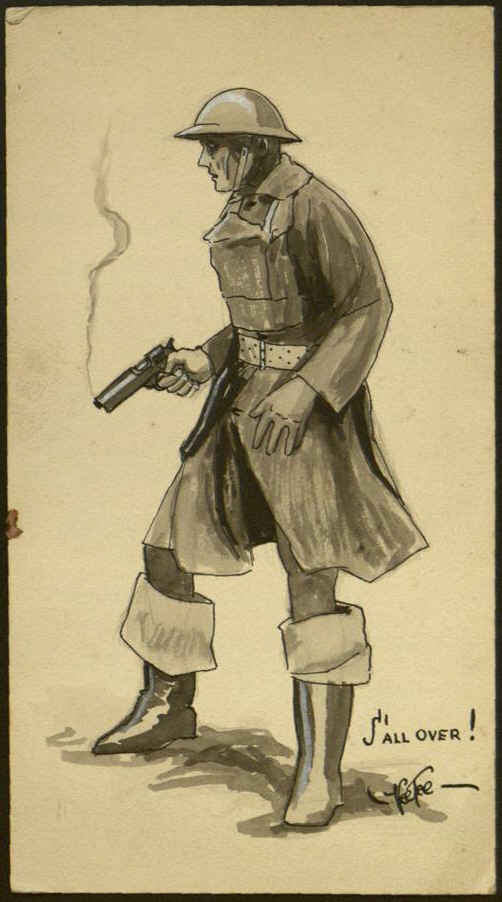
From: An Unidentified 1920s Comic Book

The Under-appreciated Belgian Army
Here's a little-known secret about World War I: the Allies may very well have lost without the help of the Belgian Army. Skeptical? Read some of these articles before you make up your mind.
 King Albert, Commander-in-Chief
King Albert, Commander-in-Chief
 Battle of Haelen: Belgium's First Victory
Battle of Haelen: Belgium's First Victory
 The Importance of the Seige of Antwerp
The Importance of the Seige of Antwerp
 Saving the Day at the Yser
Saving the Day at the Yser
 Belgian Expeditionary Corps in Russia
Belgian Expeditionary Corps in Russia
 Belgian Army Order of Battle 1918
Belgian Army Order of Battle 1918
 Battle of Houthulst Forest 1918
Battle of Houthulst Forest 1918

First To Mobilize?
Students of the Great War sometimes hear that in 1914 mobilizing a nation's armed forces was the equivalent to declaring war. The trains, it was said, couldn't be turned back once they were rolling. While this is an exaggeration of the 1914 conditions in the literal sense, the serial triggering of ultimatums together with the difficulty of reversing the process of moving troops to the front probably overwhelmed the various governments. So — who did mobilize first? Who tilted that first domino over?
The answer is that it was Serbia on 25 July 1914, the same day it replied to the onerous Austro-Hungarian ultimatum. Most likely, they figured whatever answer they made was bound to be deemed as inadequate, so they ought to get ready for what was coming. Austria-Hungary responded with their own mobilization the next day, and the race to Armageddon was on.
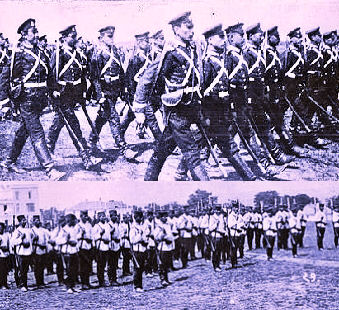
Serbian Officers and Soldiers on Parade

You can be a virgin in horror the same as in sex. How, when I left the Place Clichy, could I have imagined such horror? Who could have suspected, before getting really into the war, all the ingredients that go to make up the rotten, heroic, good-for-nothing soul of man? And there I was, caught up in a mass flight into collective murder, into the fiery furnace…. Something had come up from the depths. . . .Men are the thing to be afraid of, always, men and nothing else.
Louis-Ferdinand Céline,
Journey to the End of the Night, 1932
|

|

Organizations & Resources
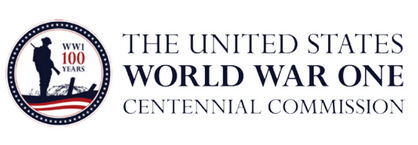
worldwar-1centennial.org/
|
The St. Mihiel Trip-Wire this month features two institutions that have already done tremendous work preserving our military heritage and in preparing for the centennial — especially by providing quality information on the Internet. We look to them to continue and accelerate their commemorative efforts. MH
The American Battle Monuments Commission
The American Battle Monuments Commission, established by the Congress in 1923, is an agency of the executive branch of the federal government. It will play a central role in America's commemoration of the First World War. Since 6 April 1917 it has been charged with designing, constructing, operating, and maintaining permanent American cemeteries, memorials, and monuments in foreign countries. Consequently, the commission is the nation's ongoing presence on our overseas battlefields and their staff represent us.
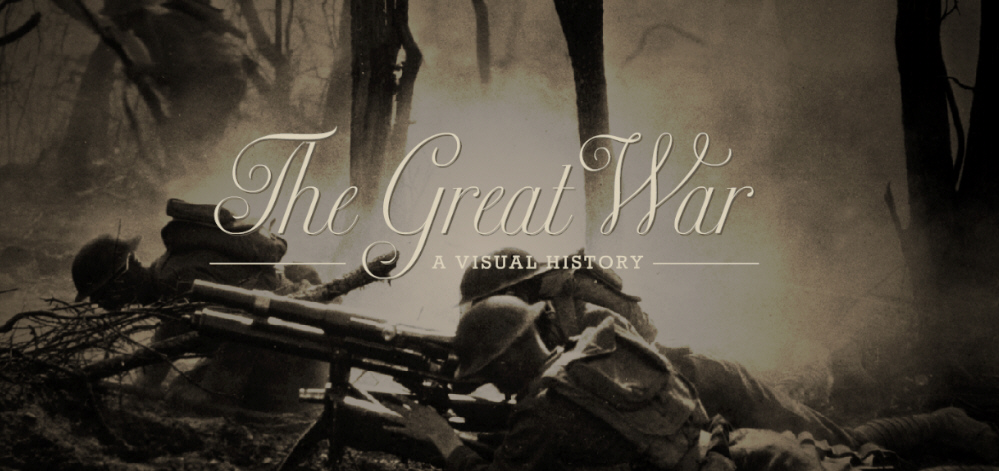
Click on Image to Access
Download Will Start in Separate Window
The commission has recently created and made available online absolutely superb histories of both World Wars. The project historian was former chief historian of the U.S. Army, Brigadier General John S. Brown. It was produced by Dog-Green Productions with the technical assistance of Belle & Wissell of Seattle. Naturally, here we will focus on their WWI presentation, The Great War — A Visual History, but the program on the Second War is equally good.
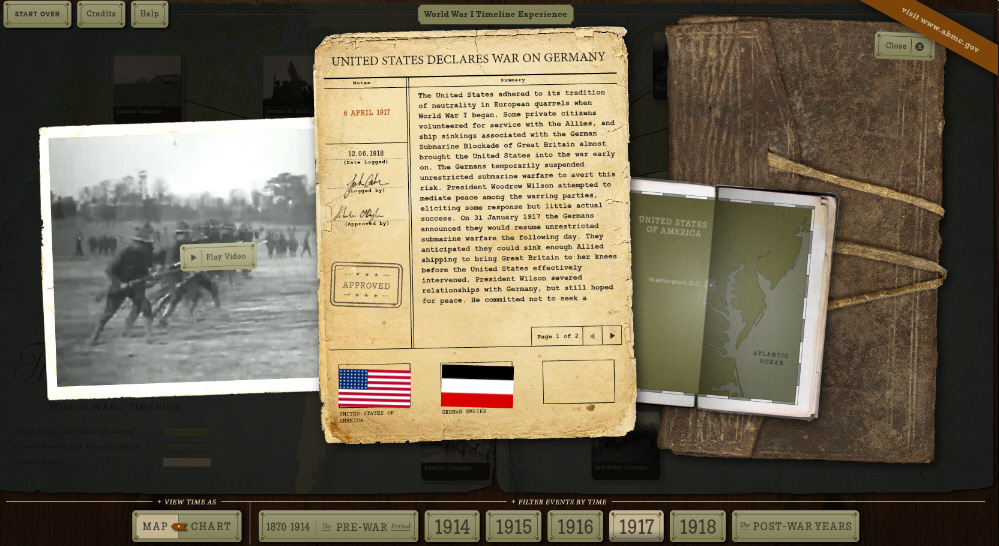
Typical Page with Video, Discussion, and Map Kit
Using images, essays, maps, and videos, The Great War covers the war's origins, battles, politics, and heritage right up to the eve of the Second World War. It is very user-friendly and has two methods of sorting through the hundreds of topics, via year-by-year chronologies or maps. The articles are clear and succinct, the videos surprisingly clear looking on computer screens. One technical suggestion, make sure your Adobe Flash Player is up to date.
Facebook subscribers may enjoy the Commission's Photo Stream that includes a good assortment of images from the WWI monuments and cemeteries
Breaking News from the American Battle Monuments Commission, via Mr. Tim Nosal, Acting Chief of Public Affairs. ABMC. (This came in as we were preparing this issue.)
ABMC is moving in the direction of developing a much more active outreach program to teach people about ABMC and those we honor in our American cemeteries overseas. The best way to do this is through education. As such, we developed the idea of producing education materials that can be used in American classrooms that integrate ABMC's resources and the people we honor in the teaching of American history, the fine arts and the language Arts. With the approaching WWI Centennial it makes good sense to embark on an Education program focused on WWI. This will be the agency's first effort in this direction.
Last month we awarded a contract to the University of North Carolina and Virginia Tech who partnered on a proposal. The two schools will develop a teacher's institute that will focus on WWI and the Meuse-Argonne campaign as the campaign is somewhat of a unique American experience. The teachers will learn about WWI, ABMC, resources in NARA, and will spend 12 days in Europe studying ABMC sites. After the field study, the teachers will brainstorm lesson plans and teaching ideas that ABMC will publish and distribute via the ABMC website. The teachers will in turn present these materials at conferences and professional development workshops. All lessons and teaching ideas will be developed with the common-core standards and state standards in mind. This way we will have tools developed by teachers that fit within existing curriculum improving the chance that other teachers will in turn use these materials in the classroom. Ultimately, the idea is to teach children of Americans memorialized overseas and place those individuals within the context of the war and the meaning of the war for Americans and the world.
Once this project is complete, we will move similarly toward WWII. TN
The First Division Museum at Cantigny
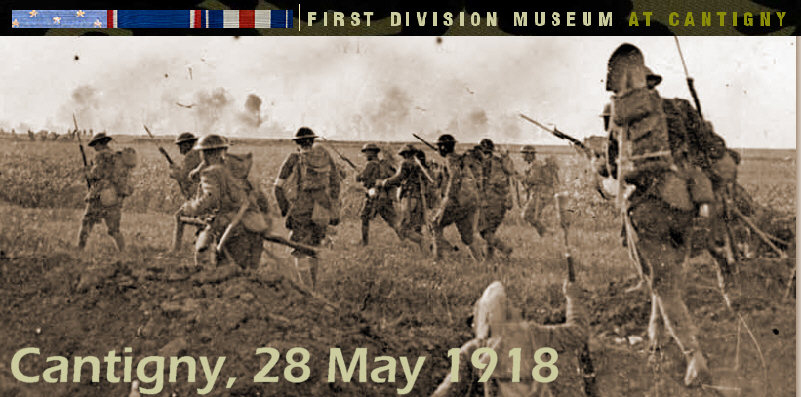
While focused on the Big Red One, which had been the unit of its benefactor, Col. Robert McCormick, in the Great War, the First Division Museum at Cantigny (i.e. the former McCormich Estate located in Wheaton, IL) under the earlier leadership of John Votaw and now Keith Gill has been a terrific national resource for everyone interested in General Pershing's AEF. This will certainly continue through the centennial.
Even now, though, they are already presenting outstanding online resources for anyone interested in the American experience in the Great War. Bookmark these features and tell your friends about them.
|
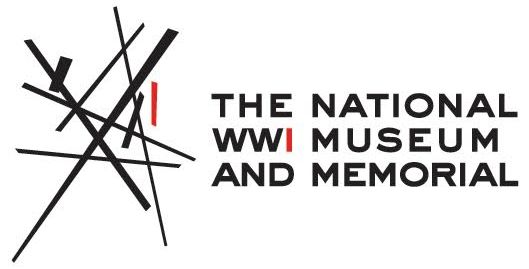
theworldwar.org/
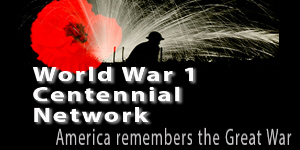
www.ww1-centennial.org/

history.army.mil/

www.firstdivisionmuseum.org/

www.abmc.gov/
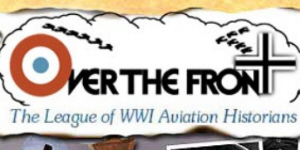
www.overthefront.com/

www.nationalmuseum.af.mil/
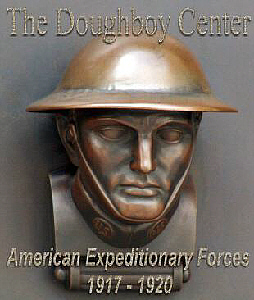
www.worldwar1.com/dbc/

wwi-inventory.org/

wisconsinhistory.org/

www.uswarmemorials.org/
|
|

Mid-1913
The Rush to Fill the Ranks
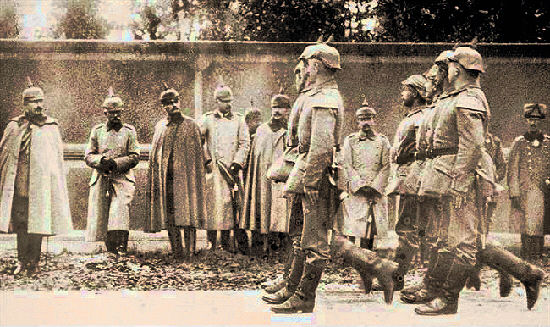
The Kaiser Reviews His Troops on the Eve of War
By early to mid-1913 the Balkan situation and a growing sense of defensiveness by European leaders over the cascading series of disagreements and crises seems to have led to an unstated acceptance of the possibility of imminent war. All the major land powers concluded they needed more bodies in uniform. In their own fashions they initiated legislative measures to accomplish this.
Russia
In March, Russia began this cycle with the unveiling of a five-year "Great Program" of expansion before the Imperial Council by the military leadership. This naturally quickly got the attention of the members of the Triple Alliance and encouraged subsequent responses from them. Being Imperial Russia, though, the process there took the longest to work through and was not fully approved until June 1914. Nevertheless, its implementation added two full corps to the army and substantial increases and modernization in artillery.
France
In May, with the backing of President Raymond Poincaré, a controversial bill known as the "Three Year Law" was introduced. It was intended to allow France to match the size of the German Army on mobilization and (this was not so publicized at the time) to make it possible for France to launch the offensive operations contemplated under the latest war plan. An immediate boost was provided by calling up two new classes simultaneously, combined with an extension to three years active service for those already in uniform (the classes of 1910 and 1911). The bill was passed in August after an appeal to the legislature by General Joffre.
The Best Book
On the Politics of
Mobilization
|
|
Germany
The Kaiser and his generals were now looking at the two-front war they had long planned for. A shift in national priorities was in order. Immediately after gaining approval for a naval bill (something less that Admiral Tirpitz had urged), an effort was mounted to increase the strength of the army. Like the French effort it was a political "hot potato," but for another reason. The expenses of building the fleet had made the Reichstag resistant to cost increases that could increase tax burdens. After much sparring, a compromise was reached on 30 June. In October the final measure was approved which added 136,000 enlisted men and included many reorganizing measures regarding the army, reservist and home guard, which would facilitate the mobilization in 1914. By one rough estimate, it increased the army of 1914 by one-sixth.
Austria-Hungary
During the Balkan wars the Dual Monarchy had passed a series of emergency military measures, but the overall situation of declining political stability further alarmed the leadership, both military and political. The war ministry reported in August 1913 that increases in manpower and artillery were needed due to recent technical innovations and a diplomatic situation shifting against the Monarchy's interests. Changes were approved by October 1913 with the support of one-time anti-militarist Hungarian leader István Tisza. These included credits for war materials and for expanding the intake of conscripts to allow for a larger force on mobilization.
Sources: Pierre Miguel's writings on French politics, David Herman's on the arming of Europe, and the WWW-Virtual Library
|
|

Flyers and application form for 2014 "Opening Moves" and
"Miracle of the Marne" Trips Now Available
(download pdf file here)

Click on Image to Send Email
|
|
|

|

Sigmund Freud (1856-1939)
Psychoanalyst
The two most famous founders of modern psychiatry, Sigmund Freud and Carl Jung, were collaborators before the Great War. In 1912 they had a bitter dispute over the sexual origins of neuroses and went their separate ways. When war came, however, both found themselves personally touched by it, then utterly shocked by it, and would find their later theoretical work deeply influenced by it.
|

Freud with Sons,
Martin & Ernst
| |
At the outbreak of the First World War, Sigmund Freud, citizen of Vienna, declared himself as a faithful supporter of the Habsburg Monarchy, writing in his unique terminology, "All my libido is for Austria-Hungary." He followed the war closely but realized the failure of the German Army at the Marne meant a long war. Two of his sons volunteered to fight. Ernst, later a noted architect, served on the Eastern Front and escaped unscathed. Martin, who was wounded in Galicia and later taken prisoner of war on the Italian Front, was a greater source of anxiety for his father. Martin apparently fought and was captured near the family's regular vacation spot in the Altopiani region.
Freud senior, after 1914, became disillusioned with the war. He exchanged correspondence with Albert Einstein on the horror of war and the need for an international movement to impose peace on nations. He continued his analytic writings, but they became more and more influenced by the death and violence the war had released: "[War] strips us of the later accretions of civilization, and lays bare the primal man in each of us. It compels us once more to be heroes who cannot believe in their own death; it stamps strangers as enemies, whose death is to be brought about or desired; it tells us to disregard the death of those we love." (1915) He would also lose one of his daughters, Sophie, in the influenza pandemic.
He continued his work two more decades until the Nazi occupation of Austria in 1938. He fled to England, dying a year later. His theories have become increasingly controversial since his death and, in some circles, hated. However, his ideas still have enormous influence beyond psychiatry in anthropology, art, literature, and education.
Carl Jung (1875-1961)
Psychoanalyst
Freud's former collaborator, Swiss-born Carl Jung, had gone his own way before the war. Despite his nation's neutrality, though, he too would be drawn into the war. He claims in his biography that a series of dreams he experienced in 1913 and early 1914 were premonitions of war (read here). When hostilities ensued he found himself drafted in the Swiss military as a physician. Given command of an internment camp for British officers, Jung ran it competently and humanely, encouraging the prisoners to pursue education and self-discovery. Yet, he saw the war as gravely damaging civiliation. The war, he believed, made him feel ill.
|
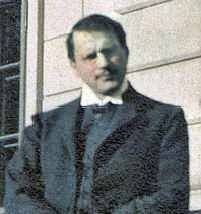
Carl Jung
| |
His sense of distress led him to pursue a path of self-analysis and creativity that would shape his understanding of an unconscious mind with individual and collectively held elements and symbols. He began recording his observations and artistic expressions of his insights in 1914 in a work known as the "Red Book" that has just recently come to light. This work appears to have been the source of Jung's reflections that deeply influenced his writings about mythology, religion, and fairy tales. Unlike Freud, Jung — over time — has gained in intellectual popularity.
Jung continued seeing patients during and after the war. In a work published after his death, Jung reported that not only was he haunted by the war's tragedy, but he found himself treating numerous patients, especially Germans, who were having distressing postwar dreams (nightmares). He noticed they contained similar disturbing themes: “the tide that rose in the unconscious after the First World War was reflected in individual dreams, in the form of collective, mythological symbols which expressed primitivism, violence, cruelty: in short, all the powers of darkness." Through his patients, Jung apparently apprehended the darkening future of Europe.
|
|
|

Origins and Opening Battles
For a thorough understanding and appreciate the beginning of the Great War, the editors recommend these works for your library.
|
|
| Click Refresh/Reload If Book Covers Do Not Appear |
|

Gas Protection for Animals
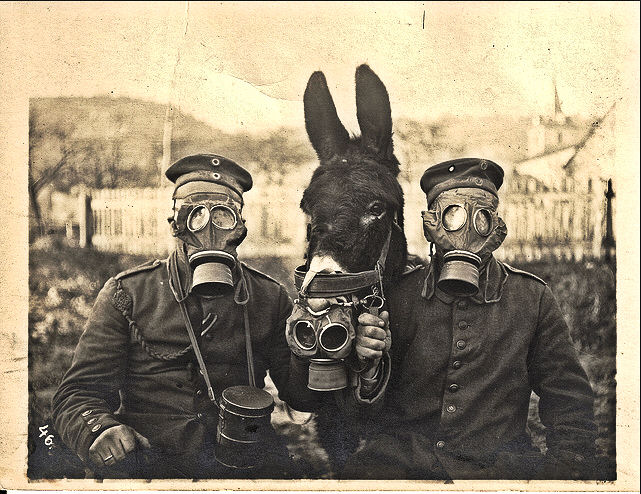
Despite the somewhat comical sensibility of this photo (younger readers may want to ask mom and dad about Francis the Talking Mule), protecting animals from gas was a major concern for all the combatants during the war. The millions of horses, mules, and dogs used for drayage were indispensable and needed protection. Many were given masks of a type, some specially designed, but not in the case shown here. A mask for humans has been adapted for the animal, leaving it without eye protection. Dogs could be outfitted with a hood, but the heads of the mules and horses were too big and the animals too resistant to having their heads covered. Also, the problem of separate aviator-type goggles fogging up was never quite solved.
A particularly challenging case was that of the messenger pigeons. They required specially designed roosts and carrying cases for transport.
Sources: Tony Langley Collection and the Medical Dept., WWI Document Archive
|
|
|

The Fight for High Wood
Where: 75-acre forest at the Somme Battlefield, six miles northeast of Albert, named Bois des Fourcaux in French
When: 14 July - 15 September, 1916, a sub-operation of the Battle of Bazentin Ridge, which was a sub-battle of the Battle of the Somme, 1 July - 18 November, 1916
Attacking Force: British Fourth Army, commanded by Lt. General Henry Rawlinson
Opposing Forces: German 1st and 2nd Armies, commanded by Generals Fritz von Below and Max von Gallwitz, respectively
|
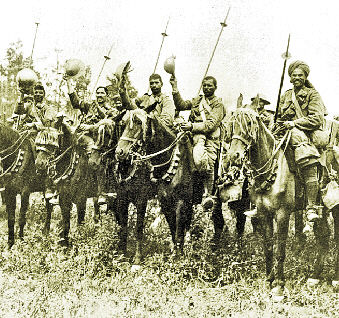
Indian Lancers, Near High Wood
|
Memorable as: 1.) The infamous site of still unrecovered corpses, that caused a dreadful stench in the summer of 1916; 2.) the occasion of the only cavalry charge during the Battle of the Somme; and 3.) a battle noted in many war memoirs and literary sources (such as by Robert Graves, who received a near-fatal wound at High Wood, in Goodbye to All That) as characteristic of attritional warfare.
The Story:
Following the failure of the first day's attack on the Somme, General Haig focused operations on the area south of the Albert-Baupame road. This area features a series of small woods in something of an open arc as they faced the advancing British. In the middle and slightly higher than the others was one small forest that became known as "High Wood". Assaulting the woods in a left to right sequence, the British Army arrived at High Wood on 14 July. After some delay, the cavalry—the 7th Dragoons & the Indian lancers of the 20th Deccan Horse—was sent into the wood. They held the edge for almost a day, but the Germans returned in force and pushed them out the next day. A two-month battle within a battle within a battle ensued.
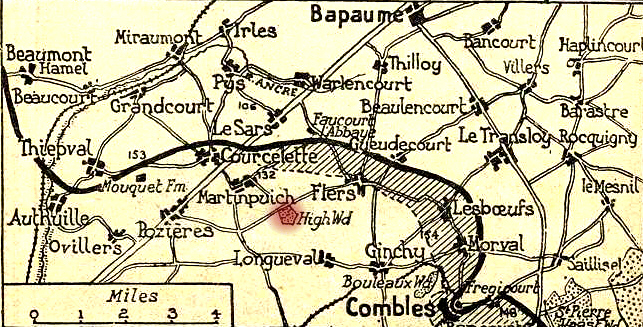
Location of High Wood after the September Offensive
That action would be the Great War circa 1916 in microcosm: piecemeal attacks grabbing a piece of trench, followed by counterattacks to recapture them. A key position in the wood was an improvised trench network known as the "Switch Line" that ran through the northern edge of the trees. The list of British divisions sent to take the position is a long one: 33rd, 5th, 7th, 51st, and 33rd (again). Still their German opponents held the wood.

High Wood Today
In mid-September, however, in a broader operation that included the first use of tanks, a fresh force, the 47th "London" Division, was brought in to mount an assault on High Wood. The tanks (deployed here in lieu of artillery by order of the corps commander) were not much help in the forest, but mass-use of mortars proved to be the key. Four days of fighting and 4,500 casualties later, High Wood was secured. The division's commander was relieved over the excessive casualties.
Sources: Commonwealth War Graves, Wikipedia, FirstWorldWar.com.
|
|
|
Thanks to each and every one of you who has contributed material for this issue. Until September, your editor, Mike Hanlon. |
|
 (Or send it to a friend)
(Or send it to a friend)
|
Design by Shannon Niel
Content © Michael E. Hanlon
|
|
|






